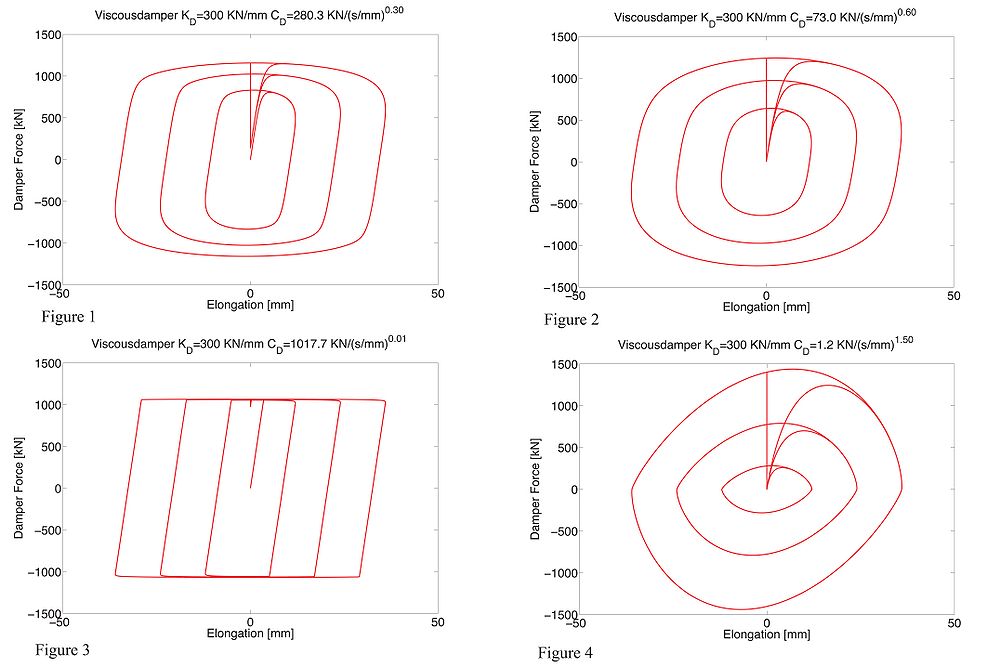ViscousDamper Material: Difference between revisions
Jump to navigation
Jump to search
No edit summary |
No edit summary |
||
| Line 1: | Line 1: | ||
{{CommandManualMenu}} | {{CommandManualMenu}} | ||
This command is used to construct a ViscousDamper material, which represents the Maxwell Model (linear spring and nonlinear dashpot in series). The | This command is used to construct a ViscousDamper material, which represents the Maxwell Model (linear spring and nonlinear dashpot in series). The ViscousDamper material simulates the hysteretic response of viscous dampers. | ||
{| | {| | ||
| Line 51: | Line 51: | ||
'''References''': | '''References''': | ||
{| | {| | ||
| style="width:5px" | '''[1]''' || | | style="width:5px" | '''[1]''' || Oohara, K., and Kasai, K. (2002), “Time-History Analysis Models for Nonlinear Viscous Dampers”, Proc. Structural Engineers World Congress (SEWC), Yokohama, JAPAN, CD-ROM, T2-2-b-3 (in Japanese). | ||
|- | |- | ||
|'''[2]''' || | |'''[2]''' || Kasai K, Oohara K. “Algorithm and Computer Code To Simulate Response of Nonlinear Viscous Damper” Passively Controlled Structure Symposium 2001, Yokohama, Japan (in Japanese). | ||
|- | |- | ||
|} | |} | ||
Code Developed by : <span style="color:blue"> Prof. Kazuhiko Kasai (Tokyo Institute of Technology) and implemented by '''''[http://dimitrios-lignos.research.mcgill.ca/PAkcelyan.html Sarven Akcelyan]''''' & '''''[http://dimitrios-lignos.research.mcgill.ca/PLignos.html Prof. Dimitrios G. Lignos]''''', (McGill University) </span> | Code Developed by : <span style="color:blue"> Prof. Kazuhiko Kasai (Tokyo Institute of Technology) and implemented by '''''[http://dimitrios-lignos.research.mcgill.ca/PAkcelyan.html Sarven Akcelyan]''''' & '''''[http://dimitrios-lignos.research.mcgill.ca/PLignos.html Prof. Dimitrios G. Lignos]''''', (McGill University) </span> | ||
Revision as of 23:23, 21 August 2013
- Command_Manual
- Tcl Commands
- Modeling_Commands
- model
- uniaxialMaterial
- ndMaterial
- frictionModel
- section
- geometricTransf
- element
- node
- sp commands
- mp commands
- timeSeries
- pattern
- mass
- block commands
- region
- rayleigh
- Analysis Commands
- Output Commands
- Misc Commands
- DataBase Commands
This command is used to construct a ViscousDamper material, which represents the Maxwell Model (linear spring and nonlinear dashpot in series). The ViscousDamper material simulates the hysteretic response of viscous dampers.
| uniaxialMaterial ViscousDamper $matTag $K $Cd $alpha |
| $matTag | integer tag identifying material |
| $K | Elastic stiffness of linear spring (to model the axial flexibility of a viscous damper (brace and damper portion) |
| $Cd | Viscous parameter of damper |
| $alpha | Viscous damper exponent |
Examples:
| 1. Input parameters: |
| Assume a viscous damper with axial stiffness K=300.0kN/mm, viscous parameter Cd=280.3kN(s/mm)0.3, and exponent a=0.30. |
| The input parameters for the material should be as follows: |
| uniaxialMaterial ViscousDamper 1 300 280.3 0.30 |
| Using these properties, Figure 1 shows the hysteretic response of this damper for sinusoidal displacement increments of 12, 24 and 36mm and a frequency f = 0.5Hz. |
| The sensitivity of the viscous damper with respect to its axial stiffness is shown in Figures 2 to 4 for the following set of parameters: |
 |
| 2. Single story single bay frame with viscous damper |
References:
| [1] | Oohara, K., and Kasai, K. (2002), “Time-History Analysis Models for Nonlinear Viscous Dampers”, Proc. Structural Engineers World Congress (SEWC), Yokohama, JAPAN, CD-ROM, T2-2-b-3 (in Japanese). |
| [2] | Kasai K, Oohara K. “Algorithm and Computer Code To Simulate Response of Nonlinear Viscous Damper” Passively Controlled Structure Symposium 2001, Yokohama, Japan (in Japanese). |
Code Developed by : Prof. Kazuhiko Kasai (Tokyo Institute of Technology) and implemented by Sarven Akcelyan & Prof. Dimitrios G. Lignos, (McGill University)